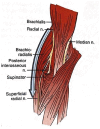Radial Tunnel Syndrome in a Collegiate Baseball Pitcher: A Case Report
- PMID: 38868935
- PMCID: PMC11569569
- DOI: 10.1177/19417381241258479
Radial Tunnel Syndrome in a Collegiate Baseball Pitcher: A Case Report
Abstract
A Division I baseball pitcher presented with chronic forearm pain in his throwing arm while pitching. Physical examination was remarkable for point tenderness over the radial tunnel. A postexertion magnetic resonance imaging (MRI) scan revealed edema around the posterior interosseous nerve. The patient underwent decompression of the nerve along with radial tunnel release, which resulted in full resolution of symptoms and return to full baseball activities. Radial tunnel syndrome is a rare phenomenon but can occur in throwing athletes. MRI immediately after a pitching session aided in accurate diagnosis and successful surgical management.
Keywords: lateral arm pain; nerve; pitching; radial tunnel syndrome.
Conflict of interest statement
The following author declared potential conflicts of interest: K.W.F. has received consulting fees from Arthrex and Exactech.
Figures


Similar articles
-
Sonography and MR imaging of posterior interosseous nerve syndrome with surgical correlation.AJR Am J Roentgenol. 2003 Jul;181(1):219-21. doi: 10.2214/ajr.181.1.1810219. AJR Am J Roentgenol. 2003. PMID: 12818863 No abstract available.
-
Transient Exertional Compressive Radial Neuropathy in a Collegiate Baseball Pitcher: A Case Report.JBJS Case Connect. 2022 Dec 8;12(4). doi: 10.2106/JBJS.CC.22.00352. eCollection 2022 Oct 1. JBJS Case Connect. 2022. PMID: 36820758
-
Unusual compression neuropathies of the forearm, part I: radial nerve.J Hand Surg Am. 2009 Dec;34(10):1906-14. doi: 10.1016/j.jhsa.2009.10.016. J Hand Surg Am. 2009. PMID: 19969199
-
Radial tunnel syndrome: a surgeon's perspective.J Hand Ther. 2006 Apr-Jun;19(2):180-4. doi: 10.1197/j.jht.2006.02.005. J Hand Ther. 2006. PMID: 16713865 Review.
-
[Modern opinions on treatment of the compressive neuropathies of the radial nerve].Chir Narzadow Ruchu Ortop Pol. 2007 Sep-Oct;72(5):323-6. Chir Narzadow Ruchu Ortop Pol. 2007. PMID: 18092694 Review. Polish.
Cited by
-
Diagnostic Musculoskeletal Ultrasound for the Evaluation of the Lateral Elbow: Implications for Rehabilitation Providers.Int J Sports Phys Ther. 2025 Jan 1;20(1):137-143. doi: 10.26603/001c.127528. eCollection 2025. Int J Sports Phys Ther. 2025. PMID: 39758701 Free PMC article.
References
-
- Bolster MAJ, Bakker XR. Radial tunnel syndrome: emphasis on the superficial branch of the radial nerve. J Hand Surg Eur Vol. 2009;34(3):343-347. - PubMed
-
- Bowers RL, Cherian C, Zaremski JL. A review of upper extremity peripheral nerve injuries in throwing athletes. PM R. 2022;14(5):652-668. - PubMed
-
- Dickerman RD, Stevens QEJ, Cohen AJ, Jaikumar S. Radial tunnel syndrome in an elite power athlete: a case of direct compressive neuropathy. J Peripher Nerv Syst. 2002;7(4):229-232. - PubMed
-
- Fees M, Decker T, Snyder-Mackler L, Axe MJ. Upper extremity weight-training modifications for the injured athlete. Am J Sports Med. 1998;26(5):732-742. - PubMed
-
- Ishikawa H, Hirata S, Matsuda N, Koubu Y. Posterior interosseous nerve syndrome in baseball pitcher - a case report. BAMS (Kobe). 1993;9:105-109.
Publication types
MeSH terms
LinkOut - more resources
Full Text Sources

